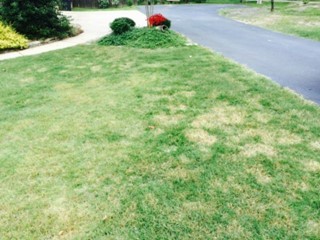Spring Dead Spot on Turf
 Searcy, Ark. –
Searcy, Ark. –
Although early in the spring we are starting to see Spring Dead Spot on Bermuda. Spring Dead Spot, caused by Ophiosphaerella spp., typically occurs on Bermuda plantings three or more years old and is the most important disease of Bermuda grass in North America.
What are the symptoms of Spring Dead Spot in Bermuda grass?
Infections begin in the fall with damaged areas becoming visible in the spring. Symptoms begin as circular depressed areas prior to spring green-up. When the turf greens up, circular patches of dead, bleached grass are apparent. The dead spots may be from 6 inches to as large as 3 feet in diameter.
After several years, the centers of active patches may contain weeds or live bermudagrass, with the patches taking the form of rings or serpentine arcs. The roots and stolons are severely rotted in these areas. Re-growth is extremely slow. Bermuda that re-colonizes the necrotic areas remains stunted due to toxins produced by the fungi.
How do I control Spring Dead Spot?
Adequate control of Spring Dead Spot is mainly through cultural practices. Recommendations are core aeration done in August or September and practices that reduce soil compaction and improve drainage. Applications of ammonium sulfate and potassium have been found to be helpful when applied in summer. Apply at least 1.0 lbs. of Potassium (K2O) per 1000 sq. ft. to turfgrass during June, July, or August.
Some experts recommend two fall applications that are three to four weeks apart. Maintain the pH in the range of 5.5-6.5. Fungicide treatments are not effective unless coupled with good cultural practices. Heritage, ProPensity, Disarm, Eagle, and Torque may be used by commercial lawn care professionals. Homeowners may use Scotts Disease EX Lawn Fungicide; or Bonide Infuse Systemic Disease Control Lawn and Landscapes; or Spectracide Immunox Fungus plus Insect Control for Lawns; or Ferti-lome F- Stop Liquid Fungicide. Make applications about 30 days before dormancy in the fall when soil temperatures are between 60ºF and 80ºF. Follow the label for specific instructions. Cultivars with good winter hardiness are less affected by Spring Dead Spot.
Take Aways: contributing factors
- Soil compaction
- Poor soil drainage
- Excessive thatch plus rainy weather
- Excessive nitrogen, especially late season
- Potassium deficiency
By Sherri Sanders
County Extension Agent - Agriculture
The Cooperative Extension Service
U of A System Division of Agriculture
Media Contact: Sherri Sanders
County Extension Agent - Agriculture
U of A Division of Agriculture
Cooperative Extension Service
2400 Old Searcy Landing Road Searcy AR 72143
(501) 268-5394
ssanders@uada.edu
The Arkansas Cooperative Extension Service is an equal opportunity institution. If
you require a reasonable accommodation to participate or need materials in another
format, please contact your County Extension office (or other appropriate office)
as soon as possible. Dial 711 for Arkansas Relay.
Pursuant to 7 CFR § 15.3, the University of Arkansas System Division of Agriculture
offers all its Extension and Research programs and services (including employment)
without regard to race, color, sex, national origin, religion, age, disability, marital
or veteran status, genetic information, sexual preference, pregnancy or any other
legally protected status, and is an equal opportunity institution.